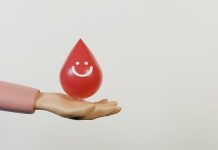
A new study from the National Institutes of Health found staying well-hydrated may be associated with a reduced risk of developing heart failure.
The team found that consuming sufficient amounts of fluids throughout life not only supports essential body functioning but may also reduce the risk of severe heart problems in the future.
The study is published in the European Heart Journal and was conducted by Natalia Dmitrieva et al.
Heart failure, a chronic condition that develops when the heart does not pump enough blood for the body’s needs, affects more than 6.2 million Americans, a little more than 2% of the population. It is also more common among adults ages 65 and older.
In the study, the team analyzed data from more than 15,000 adults, ages 45-66, who enrolled in the Atherosclerosis Risk in Communities (ARIC) study and shared information from medical visits over a 25-year period.
Approximately 11,814 adults were included in the final analysis, and, of those, the researchers found 1,366 (11.56%) later developed heart failure.
The team found looking at levels of serum sodium, which increases as the body’s fluid levels decrease, was especially useful in helping to identify participants with an increased risk for developing heart failure.
It also helped identify older adults with an increased risk for developing both heart failure and left ventricular hypertrophy, an enlargement and thickening of the heart.
Adults with sodium levels starting at 143 milliequivalents per liter (mEq/L)—a normal range is 135-146 mEq/L—in midlife had a 39% associated increased risk for developing heart failure compared to adults with lower levels.
And for every 1 mEq/L increase in serum sodium within the normal range of 135-146 mEq/L, the likelihood of a participant developing heart failure increased by 5%.
The team also found in a group of about 5,000 adults ages 70-90, those with blood sodium levels of 142.5-143 mEq/L at middle age were 62% more likely to develop left ventricular hypertrophy.
Serum sodium levels starting at 143 mEq/L correlated with a 102% increased risk for left ventricular hypertrophy and a 54% increased risk for heart failure.
These associations suggest good hydration may help prevent or slow the progression of changes within the heart that can lead to heart failure.
Fluids are essential for a range of bodily functions, including helping the heart pump blood efficiently, supporting blood vessel function, and orchestrating circulation.
While fluid guidelines vary based on the body’s needs, the researchers recommended a daily fluid intake of 6-8 cups (1.5-2.1 liters) for women and 8-12 cups (2-3 liters) for men.
Sign up for our newsletter for more information about this topic.
Previous research has found how to reverse heart failure.
In a study from the University of Auckland, researchers found a revolutionary pacemaker can re-establish the heart’s naturally irregular beat.
Currently, all pacemakers pace the heart metronomically, which means a very steady, even pace.
But in a healthy individual, it is constantly on the move. This is because the heart rate is coupled to breathing. It goes up on inspiration, and it goes down on expiration, and that is a natural phenomenon in all animals and humans.
All heart disease patients lose the heart rate variability, which is an early sign that something is going wrong.
The team says people with high blood pressure, people with heart failure, their heart rate is not being modulated by their breathing. It may be a little bit, but it’s very, very depressed, very suppressed.
There’s nothing really on the market that will cure heart failure. All the drugs will do is to make people feel better.
This new pacemaker brings back this variability, which is natural, in a way people could call it ‘nature’s pacemaker’.”
This study shows introducing a natural variation in the heartbeat improves the heart’s ability to pump blood through the body.
The other big news is that the team gets a 20 percent improvement in cardiac output, which is effectively the ability of the heart to pump blood through the body.
The team says the pacemaker is almost like a bionic device. It understands the signals from the body that tells the device when we’re breathing in and when we’re breathing out.
And then the device has to communicate back to the body and pace the heart up during breathing in and down during breathing out.
The next steps are well underway, with plans to recruit patients into a trial planned for later this year in New Zealand.
If you care about heart failure, please read studies about a big cause of heart failure, and common blood test could advance heart failure treatment.
For more information about heart health, please see recent studies about a new way to repair human heart, and results showing drinking coffee may help reduce heart failure risk.
Copyright © 2022 Knowridge Science Report. All rights reserved.



